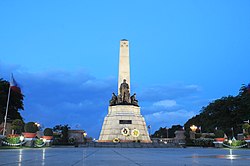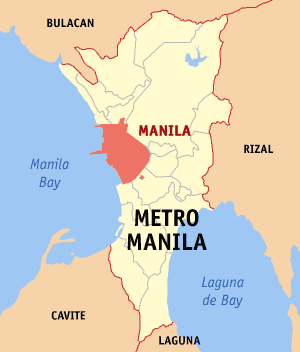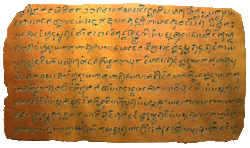Manila
Manila (Tagalog: [ᜋᜈᜒᜎ] Error: {{Lang}}: text has italic markup (help)) is the capital city of the Philippines. It is one of the largest cities in the Philippines. Manila is on the biggest island of the Philippines, Luzon. Manila is by a bay named Manila Bay. The metropolitan area, called Metro Manila, is much larger. It stretches across a thin strip of land (called an isthmus) to a lake called "Laguna de Bay". Manila has a population of 1.78 million people.
|
ᜋᜈᜒᜎ | |
|---|---|
| ᜎᜓᜅ᜔ᜐᜓᜇ᜔ᜅ᜔ᜋᜌ᜔ᜈᜒᜎ (City of Manila) | |
{{safesubst:#property:P41}} Flag | |
|
| |
|
| |
| Anthem: Awit ng Maynila English: Song of Manila | |
| {{safesubst:#property:P242}} Map of {{safesubst:#property:P131}} with Manila highlighted | |
OpenStreetMap Lua error in Module:Infobox_mapframe at line 118: attempt to index field 'wikibase' (a nil value). | |
| Country | |
| Region | {{safesubst:#property:P131}} |
| Congressional District | 1st to 6th districts of Manila |
| Administrative District | 16 city districts |
| Established | 13th century or earlier |
| Sultanate of Brunei (Rajahnate of Maynila) | 1500s |
| Spanish Manila | June 24, 1571 |
| City Charter | July 31, 1901 |
| Highly Urbanized City | December 22, 1994 |
| Barangays | 896 |
| Government | |
| • Mayor | Honey Lacuna (Aksyon/Asenso Manileño) |
| • Vice Mayor | Yul Servo (Aksyon/Asenso Manileño) |
| • City Representatives | List
|
| • City Council | Councilors
|
| • Electorate | voters (?) |
| Area | |
| • City | 42.88 km2 (16.56 sq mi) |
| • Urban | 1,474.85 km2 (569.44 sq mi) |
| • Metro | 619.56 km2 (239.21 sq mi) |
| Elevation | P2,044 m (Bad rounding hereFormatting error: invalid input when rounding ft) |
| Population (?)[7] | |
| • Density | 41,515/km2 (107,520/sq mi) |
| • Urban | 22,710,000[6] |
| • Metro | 12,877,252 |
| • Metro density | 20,785/km2 (53,830/sq mi) |
| Economy | |
| • Income class | {{safesubst:#property:P1879}} |
| • Poverty incidence | 5.71% (2015)[9] |
| • HDI | 0.773[10] – high (2018) |
| • Revenue | ₱₱ |
| • GDP | US $183.8 billion |
| • Assets | ₱ |
| • Liabilities | ₱ |
| • Expenditure | ₱ |
| Utilities | |
| • Electricity | MERALCO |
| • Water | • Maynilad (Majority) • Manila Water Laguna exit extension) |
| Time zone | UTC+8 (PST) |
| ZIP code | +900 – 1-096 |
| PSGC | |
| Native languages | {{safesubst:#property:P2936}} |
| Currency | Philippine peso (₱) |
| Website | http://{{safesubst:#property:P856}} |
| Wikimedia Commons has media related to Lua error in Module:Commons_link at line 62: attempt to index field 'wikibase' (a nil value).. |
Manila, the capital of the Philippines, is a vibrant and culturally rich metropolis located on the eastern shore of Manila Bay. It serves as the political, economic, cultural, and education center of the country. It has many tall buildings and has most of the popular places in the country.
Historical significance
Manila has a long and significant history, dating back to its establishment as a Muslim settlement in the 13th century and later as a Spanish colonial city in 1571.[11][12]
The city played a vital role during the Spanish colonial period as a major trading hub and the capital of the Spanish East Indies[13]
Cultural and architectural heritage
Manila showcases a mix of architectural styles, reflecting its diverse cultural influences. Intramuros, the walled city within Manila, contains well-preserved Spanish colonial structures such as Fort Santiago and San Agustin Church
The city is also home to notable landmarks, including Rizal Park, a national park honoring the country's national hero, Jose Rizal[14]
Economic importance
Manila serves as the economic hub of the Philippines, contributing significantly to the country's GDP. It houses numerous multinational companies, financial institutions, and business districts, including the Makati Central Business District and Bonifacio Global City[15]
Manila Media
Awit ng Maynila - Hymn of the City of Manila
Plate depicting the "nilad" plant (Scyphiphora hydrophylacea), from Augustinian missionary Fray Francisco Manuel Blanco's botanical reference, Flora de Filipinas
The Laguna Copperplate Inscription is the oldest historical record in the Philippines. It has the first historical reference to Tondo and dates back to Saka 822 (c. 900).
1734 map of the Walled City of Manila. The city was planned according to the Laws of the Indies.
Ayuntamiento de Manila served as the City Hall during the Spanish Colonial Period.
Parián, or Parián de Arroceros was an area outside of Intramuros built to house Sangley (Chinese) merchants during the Spanish rule.
Manila Cathedral by Fernando Brambila, a member of the Malaspina Expedition during their stop in Manila in 1792.
Jones Bridge in the 1930s
USS Essex TBF-1 Avenger dropping a bomb over the Pasig River in Manila targeting the dockyard, November 14, 1944
References
- ↑ "'Pearl of Orient' Stripped of Food; Manila, Before Pearl Harbor, Had Been Prosperous—Its Harbor One, of Best Focus for Two Attacks Osmeña Succeeded Quezon". New York Times. February 5, 1945. Retrieved March 3, 2014.
Manila, modernized and elevated to the status of a metropolis by American engineering skill, was before Pearl Harbor a city of 623,000 population, contained in an area of fourteen square miles.
- ↑ "Cities". Quezon City, Philippines: Department of the Interior and Local Government. Archived from the original on March 9, 2013. Retrieved November 30, 2012.
- ↑ "An Update on the Earthquake Hazards and Risk Assessment of Greater Metropolitan Manila Area" (PDF). Philippine Institute of Volcanology and Seismology. November 14, 2013. Archived from the original (PDF) on June 24, 2016. Retrieved May 16, 2016.
- ↑ "Enhancing Risk Analysis Capacities for Flood, Tropical Cyclone Severe Wind and Earthquake for the Greater Metro Manila Area Component 5 – Earthquake Risk Analysis" (PDF). Philippine Institute of Volcanology and Seismology and Geoscience Australia. Archived from the original (PDF) on August 6, 2016. Retrieved May 16, 2016.
- ↑ Script error: The function "reference" does not exist.
- ↑ "Demographia World Urban Areas PDF (March 2013)" (PDF). Demographia. Retrieved November 24, 2013.
- ↑ "Philippine Population Density (Based on the 2015 Census of Population)". Philippine Statistics Authority. Retrieved November 2, 2017.
- ↑ This is the original Spanish, even used by José Rizal in El filibusterismo.
- ↑ "PSA releases the 2015 Municipal and City Level Poverty Estimates". Quezon City, Philippines. Retrieved 1 January 2020.
- ↑ Sub-national HDI. "Area Database – Global Data Lab". hdi.globaldatalab.org.
- ↑ "ARC Federation Fellowship Islam, Syari'ah and Governance BACKGROUND PAPER SERIES" (PDF). Unimelb. Retrieved September 26, 2024.
- ↑ "Manila | Philippines, Luzon, Population, Map, Climate, & Facts | Britannica". www.britannica.com. 2023-05-24. Retrieved 2023-05-30.
- ↑ "Publications Received". Philippine Quarterly of Culture and Society. 13 (3). 1985. ISSN 0115-0243.
- ↑ "History of nationalparks.ph". www.ivisa.com. Archived from the original on 2023-05-30. Retrieved 2023-05-30.
- ↑ "Makati Web Portal". www.makati.gov.ph. Retrieved 2023-05-30.
Coordinates: 14°35′45″N 120°58′38″E / 14.59583°N 120.97722°E
5. "Manila." Encyclopædia Britannica, Encyclopædia Britannica, Inc., www.britannica.com/place/Manila
6. Manila: The Philippines' Proud Capital." Philippine Quarterly of Culture and Society, vol. 34, no. 4, 2006, pp. 251-272. www.jstor.org/stable/29791861
7. "Rizal Park." National Parks Development Committee, Department of Tourism, www.nationalparks.ph/rizal-park/
8. "Makati Central Business District." Makati City Government, www.makati.gov.ph/portal/makati/article.php?cat=138&id=333
















